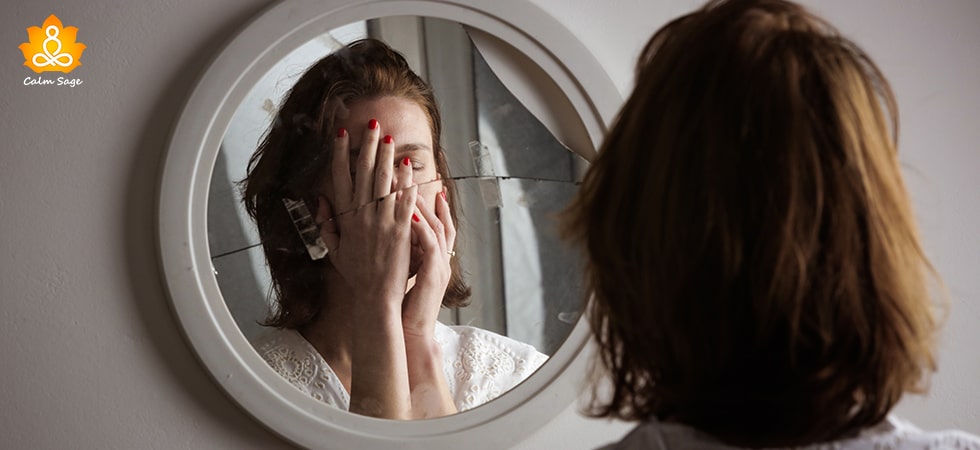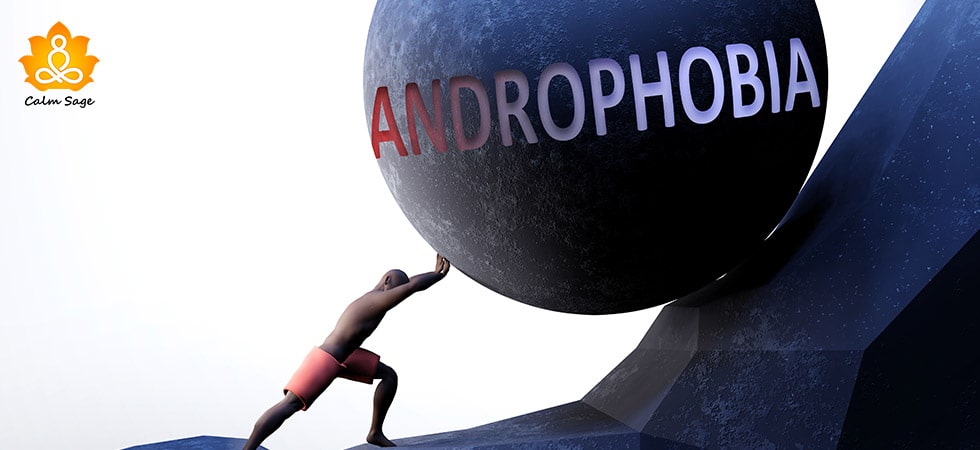Spectrophobia (Fear Of Mirrors): What is It, Symptoms, Causes, Treatment, And More!

Right after delivering a healthy baby, I was scared of looking in the mirror because of how I looked. Whenever I looked into the mirror, I felt like “This is not me.” Later, I understood that I am struggling with body-image issues, and if I will not control my fear on time, this might result in something big!
Yes, body dysmorphic disorder can also be the cause of Spectrophobia. Spectrophobia, fear of mirrors is a specific type of phobia wherein people become enormously fearful of the mirror, of their own reflection, or in rare cases, ghosts appearing in the mirror. The fear of mirrors is also referred to as catoptrophobia or eisoptrophobia.
In this blog, let us read everything we need to know about Spectrophobia. So, let’s get started!
What is Spectrophobia?
Spectrophobia is a fear of mirrors which is a rare type of phobia. People struggling with this phobia might fear looking into the mirror due to the images reflected within, the appearance of spirits or ghosts, or maybe some superstitions related to mirrors. This feeling can result in disturbed overall quality of life including professional, personal, and social relationships.
As a result, people struggling with Spectrophobia often try to avoid reflections, cover mirrors with clothes, or avoid visiting spaces with mirrors or glasses (specifically glasses with reflection). This phobia can turn into a very serious mental health issue as it disrupts the quality of life.
Examples of Spectrophobia
- People might seem anxious while thinking or encountering a reflection or mirror.
- People might start avoiding social spaces due to their extreme fear of mirrors.
- People might struggle with extreme mood swings after encountering self-reflection.
- People might avoid looking in the mirror due to body-image issues.
Quick Fact-Check Related to Spectrophobia
- Spectrophobia is a type of anxiety disorder classified under specific phobias.
- Research shows that this phobia can also be correlated with the presence of other mental health conditions such as anxiety disorder, substance use disorders, or mood disorders.
- Spectrophobia in extreme cases can also result in suicidal ideation, depression, social isolation, and more.
Spectrophobia and Other Similar Phobias
- Catoptrophobia: Another name for fear of mirrors
- Eisoptrophobia: Another name for fear of mirrors
- Scopophobia: Fear of being stared at or watched
- Trypophobia: Fear of holes or bumpy patterns
- Phobophobia: Fear of phobias
- Phasmophobia: Fear of ghosts
- Thanatophobia: Fear of death
What are the Different Types of Spectrophobia?
Spectrophobia can be divided into different subtypes, such as:
1. Fear of Mirrors or Body Image:
This type of Spectrophobia happens when someone struggles with body image issues, the thought of looking into the mirror or seeing their reflection might trigger an anxious response. Additionally, this phobia can also result in an eating disorder or body dysmorphic disorder.
2. Fear of Reflections:
This type of Spectrophobia is more focused on the fear of reflections. A person might be afraid of any material that has reflections such as large buildings with glasses, highly polished cars, or capsule elevators. Thinking or encountering reflections might trigger the phobia.
3. Spiritual Fears:
This type of Spectrophobia is more focused on religious customs, rituals, or superstitions related to mirrors or glasses. It mostly happens when someone believes that a mirror is reflecting someone else’s soul.
What are the Symptoms of Spectrophobia?
Generally, the symptoms occur in any order or a combination of the below-listed symptoms. It’s important to look out for symptoms and seek professional support in cases of suicidal ideation or self-harm. Below listed are some of the common symptoms of Spectrophobia:
- Dry mouth
- Engagement in avoidant behaviors
- Extreme anxiety
- Extreme distress
- Irregular or racing heartbeats
- Nausea
- Overwhelming fearful response
- Panic attack
- Self-harm or suicidal ideation
- Shaking
- Social avoidance
- Sweating
- Trouble breathing or shortness of breath
During emergency cases, you must immediately connect with a mental health professional or physician nearby to seek the right help and support. Additionally, you can take the help of the resources mentioned below:
- National Suicide Prevention Lifeline
- For support and assistance from a trained mental health advisor, call 988. For emergencies situations, call 911
What are the Causes of Spectrophobia?
Phobias are generally caused by traumatic situations, but there can be other reasons too. Research shows that environmental and genetic factors also play an important role in the development of specific phobias like Spectrophobia. Below listed are some of the common causes behind the development of Spectrophobia:
- Traumatic Events: Experiencing traumatic events or situations related to mirrors during childhood can also trigger phobias.
- Genetics: Having a family member with anxiety disorders or mood disorders puts a person at risk of developing Spectrophobia or any other specific phobia.
- Environmental Factors: Fears can also be exacerbated by environmental, traumatic, or genetic experiences.
- Brain Changes: Adults and children who have experienced habituation processing in the brain are prone to developing phobias.
Diagnosis & Treatment of Spectrophobia
If you think you or your loved one might be struggling with Spectrophobia, the first ever step is to connect with a mental health professional. A mental health professional is likely to follow the diagnosis and treatment process according to the currently updated 5th edition of the Diagnostic and Statistical Manual of Mental Health Disorders (DSM-5).
In order to receive a diagnosis, an individual must meet the following criteria:
- Symptoms must be present for more than 6 months
- Symptoms must not correlate with the presence of physical or mental health condition
During diagnosis, the mental health professional is likely to rule out the presence of co-existing mental health issues such as:
- Body dysmorphic disorder (BDD)
- Generalized anxiety disorder (GAD)
- Obsessive-compulsive disorder (OCD)
- Panic disorder
- Phasmophobia (fear of ghosts)
- Post-traumatic stress disorder (PTSD)
- Social anxiety disorder
- Thanatophobia (Fear of death)
Talking about the treatment process, treatment options for Spectrophobia depends on the needs and severity of the phobia. The first line of treatment is psychotherapy. While seeking therapy, a mental health professional might prescribe some medications to treat some specific symptoms.
Medications
Medications are prescribed for treating specific symptoms or when someone has a co-occurring mental health condition. Medication options include beta blockers, benzodiazepines, selective serotonin reuptake inhibitors, or monoamine oxidase inhibitors.
Psychotherapy
Psychotherapy is a first-line treatment for phobias like Spectrophobia. Below mentioned are some of the effective therapy techniques to treat specific phobias:
1. Cognitive Behavioral Therapy (CBT)
CBT is a behavioral therapy really effective for treating specific phobias. This type of therapy helps in replacing negative thoughts related to anxiety, sources of fear, and more. It also helps in teaching positive coping skills.
To know more about CBT, refer to: Mini-Guide: Cognitive Behavioral Therapy
2. Exposure Therapy
Exposure therapy is a type of CBT that involves exposing yourself to the source of fear in a completely safe environment. During exposure therapy, the therapist may discuss your emotions and feelings when exposed to the fear. This therapy is really effective to reduce and manage intense emotions and fears.
To read more about Exposure therapy, you may refer to: Exposure Therapy
3. Eye Movement Desensitization and Reprocessing (EMDR)
EMDR is an effective therapy option for specific phobias induced by trauma. The therapist works on the trauma by establishing engagement with the eye movements. It is the most effective therapy for decreasing trauma-induced Spectrophobia. To learn more about EMDR, click here.
How to Cope with the Fear of Mirrors?
Living with the fear of mirrors or other phobias can be really challenging and overwhelming especially when the phobia starts disrupting the quality of life. along with the treatment, you can take the help of the below-mentioned effective tips to cope with the fear of mirrors:
- Practice affirmations regularly and motivate yourself with some kindness and self-compassion.
- Try deep breathing exercises or relaxation techniques for de-stressing.
- Talk with your loved ones and seek their support.
- Learn more about your fears.
- Challenge your negative thoughts and write down them in a journal.
- Push your limits and challenge your fears.
Key Takeaway: When to Seek Help?
Struggling with Spectrophobia can be life-threatening or fearful, if you think you or your loved one might be struggling with Spectrophobia along with suicidal ideation or self-harm, reach out for help immediately.
Additionally, always connect with an experienced and certified mental health professional to get proper diagnosis and treatment and rule out the presence of other mental health conditions such as substance use disorders, mood disorders, and anxiety disorders.
If the information presented in this article, triggers suicidal thoughts, we request you to please contact:
- National Suicide Prevention Lifeline
- For support and assistance from a trained mental health advisor, call 988
- For emergencies situations, call 911
I hope this blog helps you understand Spectrophobia and how to overcome the fear of mirrors. For more such content, connect with us through all social media platforms.
Thanks for reading!




















